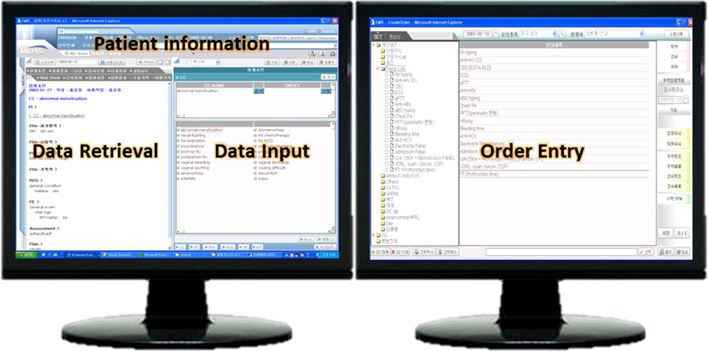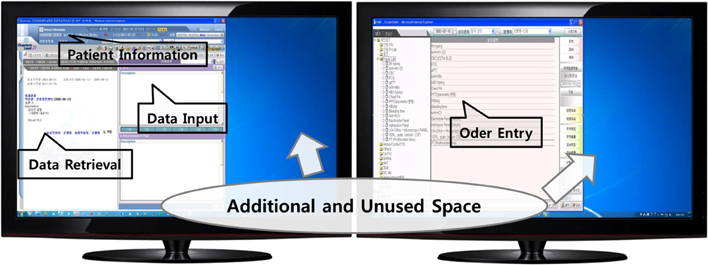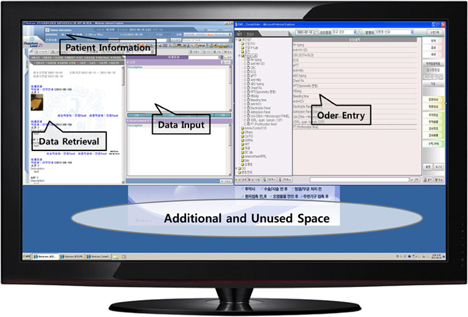Healthc Inform Res.
2012 Dec;18(4):266-271. 10.4258/hir.2012.18.4.266.
Monitor Preference for Electronic Medical Record in Outpatient Clinic
- Affiliations
-
- 1Center for Medical Informatics, Seoul National University Bundang Hospital, Seongnam, Korea. neuroandy@snubh.org
- 2Department of Family Medicine, Seoul National University Bundang Hospital, Seongnam, Korea.
- 3Health Promotion Center, Seoul National University Bundang Hospital, Seongnam, Korea.
- 4Department of Pediatrics, Seoul National University Bundang Hospital, Seongnam, Korea.
- 5Department of Plastic and Reconstructive Surgery, Seoul National University Bundang Hospital, Seongnam, Korea.
- KMID: 2284561
- DOI: http://doi.org/10.4258/hir.2012.18.4.266
Abstract
OBJECTIVES
The objective of this paper is to assess which wide type monitor configurations are preferred when physicians use an Electronic Medical Record (EMR) system in an outpatient clinic setting.
METHODS
We selected three kinds of monitor configurations available for adoption at outpatient clinics with reference to monitor market trends. Fifteen attending physicians of the Seoul National University Bundang Hospital used each monitor configuration in their outpatient clinics. After completing the outpatient sessions, they selected the best monitor configuration for criteria described in five questionnaire items. We counted the number of votes and reviewed opinions of participants.
RESULTS
The Wide Quad High Definition (WQHD) 27-inch single monitor configuration was most preferred for all questionnaire items. All participants answered that the WQHD 27-inch single monitor configuration was the best for desk space utilization. Eleven out of fifteen participants chose the WQHD 27-inch single monitor configuration as the most suitable monitor for outpatient practice.
CONCLUSIONS
This study found that physicians preferred the WQHD 27-inch single monitor configuration in outpatient clinic settings. Healthcare organizations need to consider this finding when they purchase wide type monitors for EMR systems instead of the standard type monitor.
Keyword
MeSH Terms
-
Adenine
Adoption
Ambulatory Care Facilities
Carbamates
Computer Terminals
Delivery of Health Care
Deoxycytidine
Drug Combinations
Electronic Health Records
Electronics
Electrons
Elvitegravir, Cobicistat, Emtricitabine, Tenofovir Disoproxil Fumarate Drug Combination
Humans
Organophosphonates
Organothiophosphorus Compounds
Outpatients
Personal Satisfaction
Quinolones
Thiazoles
User-Computer Interface
Surveys and Questionnaires
Adenine
Carbamates
Deoxycytidine
Drug Combinations
Organophosphonates
Organothiophosphorus Compounds
Quinolones
Thiazoles
Figure
Reference
-
1. Yoon D, Chang BC, Kang SW, Bae H, Park RW. Adoption of electronic health records in Korean tertiary teaching and general hospitals. Int J Med Inform. 2012. 81(3):196–203.
Article2. Khajouei R, Jaspers MW. CPOE system design aspects and their qualitative effect on usability. Stud Health Technol Inform. 2008. 136:309–314.3. Rose AF, Schnipper JL, Park ER, Poon EG, Li Q, Middleton B. Using qualitative studies to improve the usability of an EMR. J Biomed Inform. 2005. 38(1):51–60.
Article4. Yoo S, Lee KH, Lee HJ, Ha K, Lim C, Chin HJ, et al. Seoul National University Bundang Hospital's electronic system for total care. Healthc Inform Res. 2012. 18(2):145–152.
Article5. Kang YA, Stasko J. Lightweight task/application performance using single versus multiple monitors: a comparative study. Proceedings of Graphics Interface. 2008 May 28-30; Windsor, Canada. 17–24.6. Ball RG, North C. Analysis of user behavior on highresolution tiled displays. Proceedings of the IFIP TC13 International Conference on Human-Computer Interaction. 2005 Sep 12-16; Rome, Italy. 350–363.
Article7. Sabri AJ, Ball RG, Fabian A, Bhatia S, North C. High-resolution gaming: interfaces, notifications, and the user experience. Interact Comput. 2007. 19(2):151–166.
Article8. Czerwinski M, Smith G, Regan T, Meyers B, Robertson G, Starkweather G. Toward characterizing the productivity benefits of very large displays. Proceedings of IFIP TC13 International Conference on Human-Computer Interaction. 2003 Sep 1-5; Zurich, Switzerland. 9–16.9. Kang BJ. Large size is the mainstream also in LCD monitor market [Internet]. c2012. cited at 2012 Dec 1. Seoul, Korea: etnews.com;Available from: http://www.etnews.com/news/home_mobile/living/2257631_1482.html.10. Robertson G, Czerwinski M, Baudisch P, Meyers B, Robbins D, Smith G, et al. The large-display user experience. IEEE Comput Graph Appl. 2005. 25(4):44–51.
Article11. Stegman A, Ling C, Shehab . Salvendy G, Smith MJ, editors. A comparison between single and dual monitor productivity and the effects of window management styles on performance. Human interface and the management of information: interacting with information. 2011. Heidelberg, Germany: Springer;84–93.
Article12. NEC. Monitor size and aspect ratio productivity research [Internet]. c2010. cited at 2012 Dec 1. Sydney, Australia: NEC;Available from: http://spectraview.nec.com.au/wpdata/files/25.pdf.
- Full Text Links
- Actions
-
Cited
- CITED
-
- Close
- Share
- Similar articles
-
- Nurses’ Experiences with the Use of Electronic Nursing Record: A Qualitative Study
- The Paper-Based Medical Record Compared to the Electronic Medical Record: Documentation and Agreement of Information
- The Introduction and Management of Electronic Medical Record
- Legal Aspects of Electronic Medical Record and Its Legislation
- Comparison of Nursing Records of Open Heart Surgery Patients before and after Implementation of Electronic Nursing Record




